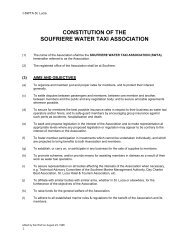WWF Cover photo - Soufriere Marine Management Association ...
WWF Cover photo - Soufriere Marine Management Association ...
WWF Cover photo - Soufriere Marine Management Association ...
Create successful ePaper yourself
Turn your PDF publications into a flip-book with our unique Google optimized e-Paper software.
is closed to scallop fishing. Ten years after the designation of the marine reserve, densities of scallops hadincreased nearly four fold (Lock and Newman 2001).Other species also appeared to be increasing in the Isle of Man closed area, including the starfish Luidia ciliaris,hermit crabs, spider crabs and brittlestars. Bradshaw et al. (2001) also found that that in terms of fauna found ingrab samples, undredged plots were more heterogeneous than dredged plots, suggesting that dredging reducesheterogeneity in benthic communities, whilst protection increases diversity. Undredged plots were typicallymore structurally complex than dredged plots. The animals found most in dredged plots were encrusting speciesof sponge and bryozoans and small ascidians, all existing close to the substrate, whereas those found most in theundredged plots were upright species of bryozoan and hydroids, with much more three-dimensional forms.Start Bay inshore potting agreement, south DevonAn area off the coast of Devon was closed to mobile gear as a result of a voluntary agreement initiated by thefishers themselves (Kaiser et al. 2000, Blyth et al. in prep). In Devon, fishers use pots to fish for crab (Cancerpagarus) and lobster (Hommarus gammarus), scallop dredges to catch scallops (Pecten maximus), and beamtrawls and otter trawls to catch plaice (Pleuronectes platessa) and soles (Solea solea). This combination of geartypes brings users into conflict because gears such as dredges and trawls either can’t fish in areas where staticgears have been set, or do fish there but remove or damage the gear. To manage this potential conflict, thefishers established areas of gear restrictions. These became formal in 1978 when a voluntary Inshore PottingAgreement was established. Kaiser et al. (2000) found that areas closed to mobile fishing gears (either yearround,or seasonally) had significantly different benthic communities to areas dredged or trawled. Communitiesin the closed area had higher biomass and more emergent fauna rather than in-fauna. An increased level ofemergent fauna leads to increased habitat complexity in those areas too. Smaller animals and scavengersdominated areas open to towed gears. Highest species diversity was found in areas closed year round to mobilegear, followed by areas closed seasonally to mobile gear, followed by areas used by mobile gear. Biomass of softcorals and hydroids was higher in areas that were closed to towed fishing gear. No data are available yet on howthe differences in benthic communities might influence fisheries, but the main aim of the closure system, toreduce conflict between users of different gears, seems to have been achieved (Kaiser et al. 2000).Key points• Closed areas can lead to rapid rebuilding of exploited populations like scallops.• Protecting areas of temperate water continental shelf can lead to habitat recovery from damage by mobilefishing gears, allowing development of more biologically rich and complex habitats.ReferencesBradshaw, C., Veale, L.O., Hill, A. S. and Brand, A.R. (2001) The effect of scallop dredging on Irish Seabenthos: experiments using a closed area. Hydrobiologia 465, 129-138.Blyth, R.E., Kaiser, M.J., Edwards-Jones, G. and Hart, P.J.B. (In review) Voluntary management in an inshorefishery has conservation benefits. Environmental Conservation.Jones, P.J.S. (1999) Economic and socio-cultural priorities for marine conservation. In Effects of Fishing onNon-target species and Habitats: Biological, Conversation and Socio-economic Issues. (Eds. M.J. Kaiser andS.J. de Groot), Fishing News Books, Blackwell Science, Oxford.Kaiser, M.J., Spence, F.E. and Hart, P.J.B. (2000) Fishing-gear restrictions and conservation of benthic habitatcomplexity. Conservation Biology 14, 1512-1525.Lock, K. and Newman, P. (2001) Skomer <strong>Marine</strong> Nature Reserve scallop survey 2000. Countryside Council forWales Science Report.Tang, S.F. (1941) The breeding of the scallop (Pecten maximus (L.)) with a note on growth rate. LiverpoolBiological Society 54, 9-28.90



